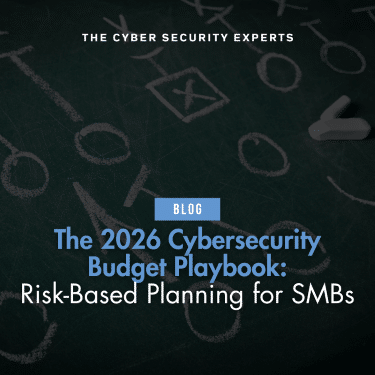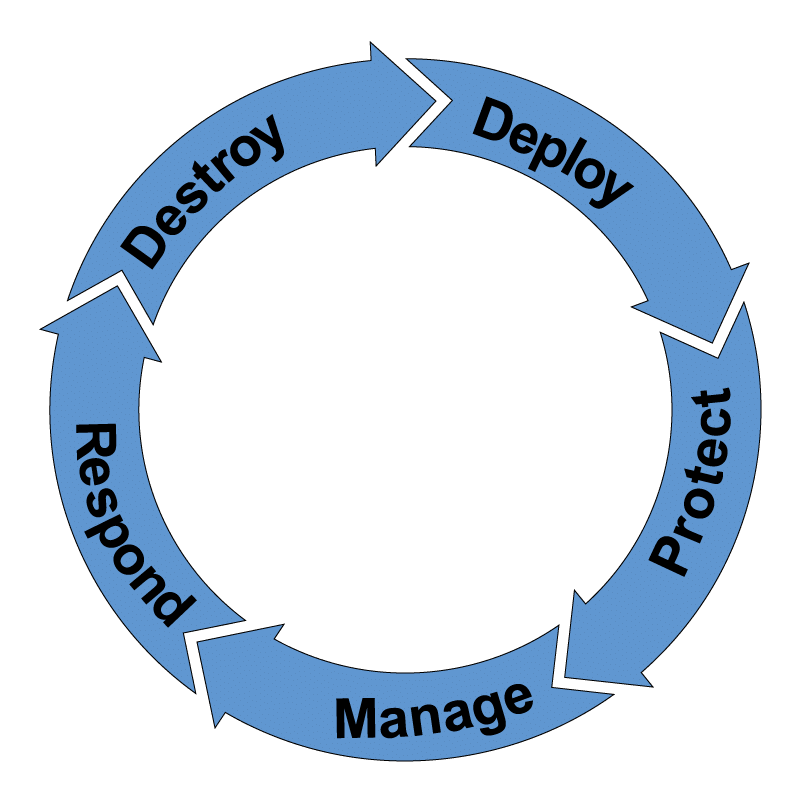The 2026 Cybersecurity Budget Playbook: Risk-Based Planning for SMBs
 Small and mid-sized businesses have reached a defining moment in cybersecurity planning. The rapid adoption of AI, the expansion of interconnected systems, and the growing sophistication of cybercrime have altered what constitutes “adequate protection.” For years, SMBs have operated with reactive budgets, often spending only after a breach or compliance scare. By 2026, this approach will no longer be viable. Cybersecurity strategy and budget allocation must now work in tandem, shaped by real-world risks and measured outcomes.
Small and mid-sized businesses have reached a defining moment in cybersecurity planning. The rapid adoption of AI, the expansion of interconnected systems, and the growing sophistication of cybercrime have altered what constitutes “adequate protection.” For years, SMBs have operated with reactive budgets, often spending only after a breach or compliance scare. By 2026, this approach will no longer be viable. Cybersecurity strategy and budget allocation must now work in tandem, shaped by real-world risks and measured outcomes.
Why 2026 Is a Turning Point for SMB Cybersecurity
Every indication suggests that 2026 will be a year of accelerated innovation and increased exposure. SMB cybersecurity spending worldwide continues to grow, but so does the complexity of the threat environment. Analysts predict strong year-over-year increases in overall security budgets; however, many smaller organizations still lag behind in maturity and process alignment.
What makes this year different is not only the technology available, but also the accountability surrounding its use. Insurers, regulators, and customers now expect businesses to prove that their investments reduce measurable risk. The board-level conversation is shifting from “how much are we spending” to “what are we achieving with that spend.” As cyberattacks become faster, more automated, and increasingly targeted, 2026 budgets will need to reflect proactive governance and the integration of risk management frameworks, rather than just compliance checklists.
Organizations that fail to budget for continuous improvement, AI-related threats, and Zero Trust adoption will find themselves at a disadvantage. The cost of inaction is rising faster than the cost of preparedness.
Not sure where your organization stands on the path to cyber resilience? Download our Cyber-Ready Scorecard, an expert-designed assessment that helps you identify strengths, reveal gaps, and build your 2026 action plan.
Building Cybersecurity Balance Across Technology, People, and Process
A successful cybersecurity budget finds its balance in three core areas: technology, people, and process. Many SMBs fall into the trap of overspending on tools without enough investment in staff or governance to manage them effectively. Others pour resources into training and awareness while leaving legacy technology unpatched and underprotected.
An effective allocation model spreads spending strategically across these categories. Technology investments typically account for 40-50% of the overall cybersecurity budget, encompassing platforms, automation, detection, and scalability. Personnel typically account for 30-40% of expenses, including salaries, upskilling, and external partnerships. The remaining 10-20% supports process and governance through compliance programs, documentation, and training.
The exact percentages will vary, but the underlying principle remains: each area amplifies the others. A modern detection system only performs well if trained personnel manage it, and those personnel only succeed when backed by a consistent policy and process.
Using Growth Scenarios to Guide Cyber Risk Reduction for SMBs
Not every business will grow its cybersecurity budget in the same way. Some will maintain a flat spend, while others will invest aggressively to meet new maturity goals. The key is to align growth with achievable risk reduction.
For organizations with a flat budget, the priority becomes consolidating tools and improving efficiency. Reducing redundancy and overlapping licenses can yield 10-15% more effectiveness without increasing costs. Those who can afford to expand spending slightly should target clear gaps in their environment, such as unmonitored endpoints, unprotected credentials, or outdated policies. Even a small increase of 2-5% can produce a 20-30% improvement in overall risk reduction when applied with focus.
Businesses expecting moderate or significant growth in 2026 can move beyond remediation and start implementing transformation. A 5-10% increase allows for Zero Trust adoption, stronger segmentation, and AI-powered detection. Larger investments above 10% open the door to full modernization, advanced response frameworks, and ongoing resilience programs.
The takeaway is straightforward: cybersecurity budgets should scale in proportion to both ambition and risk exposure. The most effective plans do not only add dollars; they direct each new dollar to the area of greatest impact. Read our latest analysis of the seven extinction-level cyber threats redefining SMB risk management in 2026.
Strategic Cyber Priorities That Cannot Be Ignored
Zero Trust must take center stage in 2026 planning. It is no longer a future vision reserved for large enterprises. For SMBs, adopting a Zero Trust mindset means limiting access, monitoring identity, and segmenting the network to minimize lateral movement. Allocating a portion of the technology budget to microsegmentation can dramatically contain the spread of attacks and reduce dwell time once an intrusion occurs.
AI risk management is another emerging priority. Threat actors are already leveraging artificial intelligence to craft more sophisticated phishing campaigns, identify vulnerabilities more quickly, and automate attacks. Businesses must match that sophistication by investing in AI-driven detection tools, anomaly monitoring, and governance frameworks. The introduction of ISO/IEC 42001:2023 and NIST’s AI Risk Management Framework offers clear guidance for responsible implementation and oversight.
Identity security remains the foundation of all other controls. Most breaches still begin with stolen or misused credentials. Strengthening multifactor authentication, privileged access controls, and identity lifecycle management delivers immediate value, especially in hybrid and remote environments.
Finally, visibility and resilience should be embedded into every 2026 budget. Logging, continuous monitoring, and incident response planning are the operational backbone of risk-based planning. Many SMBs underestimate the recovery cost of even a minor incident; a documented and tested plan significantly shortens downtime and limits financial loss.
Turning Cybersecurity Budgets into Measurable Risk Reduction
The difference between a compliant organization and a resilient one lies in how it measures success. A risk-based budget must connect every expenditure to a defined outcome.
Start with a clear baseline. Estimate your current exposure across data loss, operational disruption, and reputational harm. Then evaluate each potential investment for its capacity to reduce that exposure. For instance, implementing Zero Trust controls might reduce the likelihood of credential-based compromise by half. Consolidating tools might lower response times by a measurable percentage.
Once those metrics are established, prioritize high-impact investments first. Track improvement through metrics such as incident frequency, time to detect and respond, and financial exposure avoided. These indicators enable leaders to present cybersecurity spending as an investment that directly supports business continuity, rather than a cost of doing business.
Framing the budget in terms of risk reduction also improves communication with executive leadership and boards. When business leaders see the link between dollars spent and loss avoided, they are more likely to support long-term, proactive planning.
Avoiding Common Pitfalls in Cybersecurity Planning
Even with a strong framework, common mistakes can still undermine cybersecurity planning. Overreliance on technology without operational maturity remains a leading challenge. A security stack may be sophisticated, but without skilled personnel and defined processes, it becomes underutilized. Integration costs also need to be factored into every budget. A new solution that requires excessive customization or management time can erode expected savings.
Compliance remains another area of confusion. Meeting regulatory requirements is essential, but compliance alone does not equal security. Risk reduction must go further, incorporating continuous testing, user awareness, and internal governance to ensure comprehensive protection.
Finally, flexibility must be built into every 2026 plan. Threats are expected to evolve mid-year, and technology roadmaps may also shift. Setting aside 5-10% of the overall cybersecurity budget for contingency ensures the ability to adapt without derailing the entire plan.
Risk-Based Budgeting for a More Accountable Future
Risk-based budgeting will define the next stage of cybersecurity maturity for SMBs. It requires intention, measurement, and honest evaluation. Begin by assessing your current posture against established frameworks, such as NIST or CIS. Identify where the most significant risks lie, and build investment scenarios around those priorities.
The best budgets for 2026 will not simply defend against today’s threats; they will create measurable resilience for the years ahead. When technology, people, and processes align, cybersecurity becomes less of an expense and more of a foundation for growth.
Don’t wait for a breach or compliance audit to test your cybersecurity readiness. Download our Cyber-Ready Scorecard today to see how your organization measures up, and get a customized roadmap for improvement.








